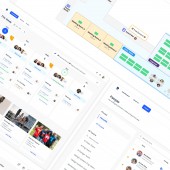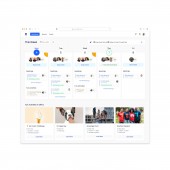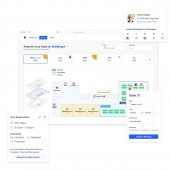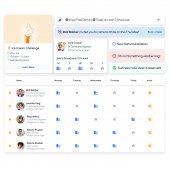
| THE AWARD |
| CATEGORIES |
| REGISTRATION |
| SUBMIT YOUR WORK |
| ENTRY INSTRUCTIONS |
| TERMS & CONDITIONS |
| PUBLICATIONS |
| DATES & FEES |
| METHODOLOGY |
| CONTACT |
| WINNERS |
| PRESS ROOM |
| GET INVOLVED |
| DESIGN PRIZE |
| DESIGN STORE |
| THE AWARD | JURY | CATEGORIES | REGISTRATION | PRESS | WINNERS | PUBLICATIONS | ENTRY INSTRUCTIONS |
Desky Office Desk Booking Software by Zhiqi Lin |
Home > Winners > Design #159027 >Interview |
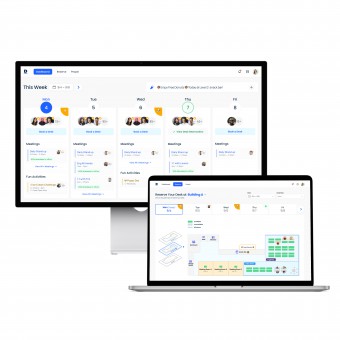 |
|
FS: What is the main principle, idea and inspiration behind your design?
ZL: The main principle behind Desky is to enhance the hybrid work experience by making it easier for employees to plan their office visits. The inspiration came from observing the challenges people faced in transitioning back to the office post-pandemic, particularly the lack of motivation and the struggle with commuting. Desky aims to bridge this gap by providing a seamless and engaging way to manage office presence.
FS: What has been your main focus in designing this work? Especially what did you want to achieve?
ZL: The main focus in designing Desky was to create a user-friendly platform that simplifies the hybrid work model. I wanted to achieve a design that helps employees make informed decisions about their office visits, promotes collaboration, and fosters a connected office culture.
FS: What are your future plans for this award winning design?
ZL: Future plans for Desky include incorporating user feedback to further refine its features, exploring integrations with other workplace tools, and potentially partnering with organizations to implement Desky on a larger scale. The goal is to continuously improve the user experience and expand its reach.
FS: How long did it take you to design this particular concept?
ZL: Designing Desky took approximately six months, from initial concept to final prototype. This period included extensive research, user testing, and multiple iterations to ensure the design met user needs effectively.
FS: Why did you design this particular concept? Was this design commissioned or did you decide to pursuit an inspiration?
ZL: I decided to pursue Desky out of personal inspiration, driven by the need to address the challenges of hybrid work post-pandemic. The idea was to create a tool that would make the return to office more manageable and enjoyable for employees.
FS: Is your design being produced or used by another company, or do you plan to sell or lease the production rights or do you intent to produce your work yourself?
ZL: Currently, I am exploring opportunities to partner with companies to implement Desky. I am open to selling or leasing the production rights to organizations that align with the vision of improving the hybrid work experience.
FS: What made you design this particular type of work?
ZL: The realization that many people were struggling with the hybrid work model, particularly the transition back to the office, motivated me to design Desky. I wanted to create a solution that could help ease this transition and improve overall workplace satisfaction.
FS: Where there any other designs and/or designers that helped the influence the design of your work?
ZL: Yes, various workplace management tools and collaboration platforms influenced the design of Desky. Additionally, I sought feedback from other designers and workplace professionals to ensure the design addressed real-world needs effectively.
FS: Who is the target customer for his design?
ZL: The target customers for Desky are organizations implementing a hybrid work model, as well as employees who need an efficient way to plan their office visits and enhance their in-office collaboration.
FS: What sets this design apart from other similar or resembling concepts?
ZL: Desky stands out due to its comprehensive and user-centric approach to managing the hybrid work experience. Unlike traditional workplace management tools, Desky integrates social and collaborative elements, such as colleague schedule tracking and interactive office maps with event highlights. These features not only enhance productivity but also foster a more connected and engaged office environment. Additionally, Desky is designed to make planning the work week enjoyable and engaging. By incorporating playful elements and intuitive interfaces, it turns the often mundane task of scheduling into a fun and seamless experience, helping employees look forward to their office visits and collaboration opportunities.
FS: How did you come up with the name for this design? What does it mean?
ZL: The name "Desky" reflects the core functionality of the platform—managing desk bookings and office schedules. It’s simple, memorable, and directly conveys the purpose of the tool.
FS: Which design tools did you use when you were working on this project?
ZL: For Desky, I primarily used Figma for designing the interface and creating interactive prototypes.
FS: What is the most unique aspect of your design?
ZL: The most unique aspect of Desky is its focus on enhancing the hybrid work experience by integrating social and collaborative elements. Features like colleague schedule tracking and interactive office maps with event highlights set it apart from traditional workplace management tools.
FS: Who did you collaborate with for this design? Did you work with people with technical / specialized skills?
ZL: I worked on Desky entirely solo, which allowed me to have complete creative control and ensure that every aspect of the design aligned with my vision. However, I did reach out to other designers for feedback. Their insights were invaluable in refining the design and ensuring it met high standards of usability and aesthetics.
FS: What is the role of technology in this particular design?
ZL: Technology plays a central role in Desky, enabling seamless integration with existing workplace tools and providing a smooth user experience. Advanced features like real-time updates, interactive maps, and automated notifications rely heavily on technological infrastructure.
FS: Is your design influenced by data or analytical research in any way? What kind of research did you conduct for making this design?
ZL: Yes, Desky is heavily influenced by data and user research. I conducted surveys, interviews, and usability tests to gather insights into the needs and preferences of employees and employers in a hybrid work setting. This research informed the design features and functionality.
FS: What are some of the challenges you faced during the design/realization of your concept?
ZL: One of the main challenges I faced was figuring out how to present information intuitively on the screen without overwhelming the user. Balancing the need to provide comprehensive functionality with the goal of maintaining a clean and user-friendly interface was difficult. It required extensive user testing and iteration to ensure that all features were easily accessible and that the design remained simple and engaging. This involved making tough decisions about which elements to include on each screen and how to organize them in a way that supported the user's workflow seamlessly.
FS: How did you decide to submit your design to an international design competition?
ZL: I decided to submit my design to an international design competition thanks to the encouragement from my mentor. She recognized the potential impact of Desky and believed that it would benefit from the broader recognition and feedback that such a competition could provide. Their support and belief in my work gave me the confidence to present Desky on a global stage, showcasing its innovative approach to enhancing the hybrid work experience.
FS: What did you learn or how did you improve yourself during the designing of this work?
ZL: Designing Desky taught me the importance of user feedback and iterative design. It reinforced the value of empathy in understanding user needs and highlighted the necessity of flexibility and adaptability in the design process.
FS: Thank you for providing us with this opportunity to interview you.
A' Design Award and Competitions grants rights to press members and bloggers to use parts of this interview. This interview is provided as it is; DesignPRWire and A' Design Award and Competitions cannot be held responsible for the answers given by participating designers.
| SOCIAL |
| + Add to Likes / Favorites | Send to My Email | Comment | View Press-Release |

